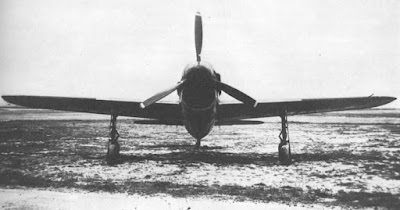The Douglas SBD Dauntless was a carrier-based dive-bomber in service with the US Navy during World War II. It was developed from the Northrop BT-1, after Northrop Corporation had been acquired by Douglas. Although it would become obsolete by 1943, the Dauntless was a very reliable and stable aircraft, with excellent handling. The pilots liked it, affectionately calling it the "Barge". Besides, at the time of introduction on February 6, 1940, the aircraft speed, range, and payload were adequate and satisfactory.
To produce the SBD Dauntless, Northrop BT-1 was converted into the XBT-2, which was the first prototype of this famous dive-bomber. It first flew on April 22, 1938, powered by the original engine, a 825-HP Pratt & Whitney R-1536-94 engine. This powerplant would soon be replaced by more powerful ones as the XBT-2 would become the XSBD-1 prototype. When it was introduced into service as the SBD-1, it was fitted with a Wright R-1820-32 radial piston engine, which delivered 1,000 HP. The US Army's variant was known as the A-24 Banshee.
The Douglas SBD Dauntless first saw combat action at the Battle of Midway on June 4, 1942. At this military engagement, it helped a lot to turn the tide of the war in the Pacific Theater, sinking four Imperial Japanese Navy's aircraft carriers; Soryu, Kaga, Akagi, and Hiryu. They had been scrambled in a hurry to assist the TBD Devastators, most of which had just been wiped out of the sky by the Japanese Mitsubishi A6M Zeros. The Devastators were too slow and not maneuverable enough to carry out the dangerous mission of striking the Japanese warships. From the Solomons and New Guinea to the Marshall Islands and the Carolines, it would continue to fly sorties also in a ground-attack role to provide fire support to the US Marines.
Technical Data/Specifications for the SBD-5 version
Type: a two-seat, single-engine, low-wing dive-bomber of all-metal construction.
Length: 10.06 m (33 ft)
Wing Span: 12.65 m (41 ft, 6 in)
Wing Area: 30.19 m2 (325 sq. ft)
Height: 3.94 m (12 ft, 11 in)
Powerplant: one 1,200-HP, Wright R-1820-60 Cyclone, radial engine.
Maximum Speed: 406 km/h (252 mph)
Rate of Climb: 518 m/min. (1,700 ft/minute)
Combat Range: 1,778 km (1,115 miles)
Armament: two fixed, forward-firing 12.7-mm (.50-cal.) M2 Browning machine guns; two trainable 7,62-mm machine guns set up in rear cockpit. One 454-bomb or two 227-kg bombs.
Below, the Douglas SBD in flight. Notice the perforated flaps on the trailing edge of wings. They had 318 oval 3-inch holes. The flaps were lowered to break the acceleration during diving and they were extended for taking off.
A group of SBD-3 Dauntless from USS Enterprise in 1943
Below, the SBD-4 version in flight around 1943.
The second production aircraft of the SBD-1 variant, identification mark 2-MB-I.








































